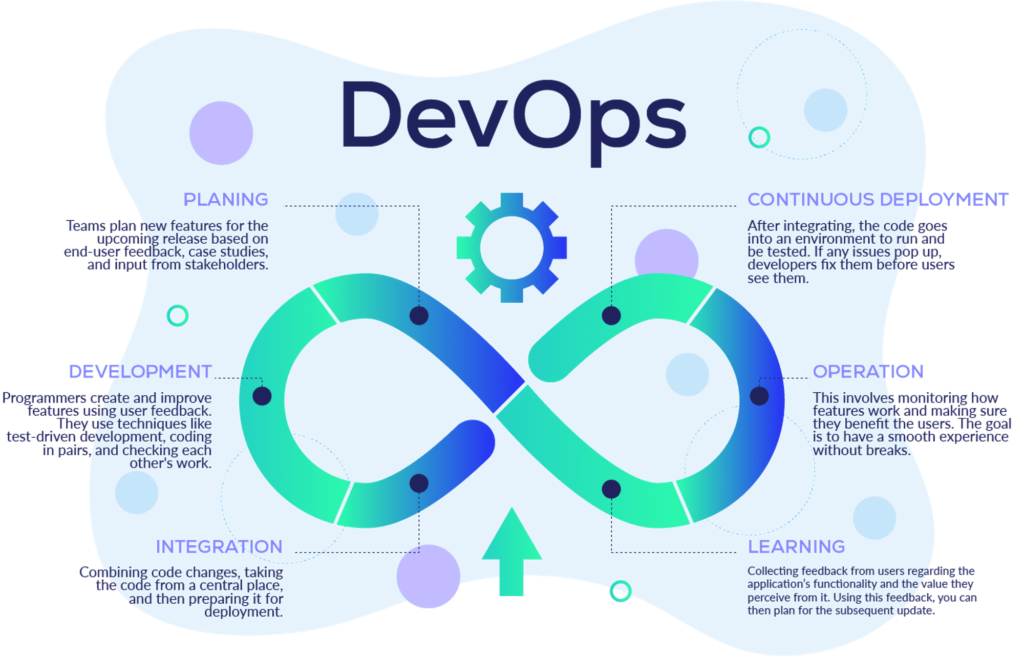
What DevOps Is and Why IT Decision-Makers Think It’s a Game-Changer

TL; DR: DevOps is reshaping how we approach software development. This article explores its importance, key principles, and detailed lifecycle. Additionally, we highlight the array of benefits it provides, setting the tone for agile and effective software delivery in modern businesses.
In 2021, the State of DevOps Report highlighted that 83% of IT decision-makers disclosed their organizations were implementing DevOps practices. Two years later and this is no longer a trend, but a reality. It underscores how DevOps is no longer just a niche approach. Instead, it has become an integral part of how businesses enhance software quality and accelerate delivery.
Join us as we dive into the world of DevOps. We’ll uncover its significance, break down its core principles and lifecycle, and highlight the major advantages it offers to both businesses and teams.
What is DevOps?
In the past, software development teams would invest months crafting extensive new code that had a widespread impact on their applications. They would then dedicate several additional months to seamlessly integrate this fresh code into their existing codebase.
Subsequently, quality assurance, security, and operations teams would allocate even more time to rigorously test the code. The outcome? Months or even years would pass between software releases, often requiring numerous significant patches and bug fixes along the way.
To accelerate development and enhance overall quality, development teams began embracing agile software development methodologies. These approaches are iterative rather than linear, focusing on making smaller, more frequent updates to the application’s codebase.
From this agile foundation, DevOps emerged, introducing new processes and tools designed to extend continuous iteration throughout the entire software delivery lifecycle.
It emphasizes the importance of bringing the development and operations teams together, ensuring they work hand in hand at every stage. This synergy results in faster deliveries, fewer errors, and a more efficient production process.
In a world where software is ever evolving, such collaboration becomes essential to meet user expectations and stay ahead in the market.
The Four Pillars That Support DevOps
From a Microsoft point of view, DevOps is built upon four core principles that drive the entire journey from project inception to delivering value to end-users: Culture, Lean Product, Architecture, and Technology.
Culture forms the bedrock of DevOps. For it to thrive, there must be an ingrained culture of growth and continuous learning. This mindset is the collective legacy of a group, shaped by the solutions they’ve developed over time to address challenges. For instance, it dictates what’s deemed acceptable or not and what’s considered important or trivial.
Lean Product development and management focus on optimizing product value by eliminating waste and ensuring that every stage in the product journey aligns with customer needs. It’s about streamlining processes and making sure that decisions are driven by real-world data and user feedback.
Architecture plays a pivotal role in DevOps. A well-designed system architecture facilitates smooth integration, scalability, and resilience. It’s about ensuring that the infrastructure can adapt and scale as per the demands of the development and operations teams. Fluidity and flexibility in architecture are crucial for rapid deployments, rollbacks, and updates.
Technology is the engine that drives DevOps, providing the tools and platforms necessary to execute the team’s vision. From continuous integration tools to containerization and cloud platforms, the right technology stack is essential. But remember, technology should serve the process, not dictate it.
With these four pillars, DevOps has transformed the traditional software development and delivery model into an integrated, agile, and efficient system.
Yet, to truly grasp the essence of DevOps, we must delve into its lifecycle.
DevOps and the Application Lifecycle

The DevOps lifecycle consists of iterative stages within a broader, automated cycle. This framework enables teams to produce high-quality software more rapidly without compromising on quality.
While different experts might name different stages, it generally encompasses these six:
Planning
In this phase, teams plan new features for the upcoming release based on end-user feedback, case studies, and input from stakeholders. The aim is to maximize the product’s business value by creating a backlog of features that, when delivered, yield the desired outcome of value.
Development
This is where programmers create and improve features using user feedback. They use techniques like test-driven development, coding in pairs, and checking each other’s work.
Integration
Now, it’s time to mix new code with the old, which is then tested and made ready for use. The process often involves combining code changes, taking the code from a central place, and then preparing it for deployment.
Continuous Deployment
After integrating, the code goes into an environment to run and be tested. If any issues pop up, developers fix them before users see them. There are usually three stages: development, testing, and final use. Each stage has stricter quality checks. A smart way to launch in the final stage is to start with a small group of users, then release to everyone once it’s stable.
Operation
Think of delivering features as “Day 1”. Once they’re up and running, “Day 2” begins with operations. This involves monitoring how features work and making sure they benefit the users. The goal is to have a smooth experience without breaks. If issues arise, the operations team spots them, alerts the right people, figures out the issue, and gets them fixed.
Learning
This stage involves collecting feedback from users regarding the application’s functionality and the value they perceive from it. Using this feedback, you can then plan for the subsequent update. Insights from previous operations are also incorporated to aid developers in preventing past mistakes. After this, the process goes back to the Planning phase, with the ongoing goal of improvement.
In addition to the main DevOps stages, there are three other key continuous processes. Testing is now woven throughout all stages, from unit testing in development to chaos testing in operations, ensuring consisting risk management. Security is integrated from the outset, as tackling issues early is both efficient and cost-effective.
Meanwhile, compliance emphasizes observability and traceability across the entire development journey, ensuring that standards are met both in the delivery pipeline and during operations.
Understanding the stages and continuous processes of the DevOps lifecycle underscores the holistic approach it brings to software development. This lifecycle is not just a methodology, but a culture shift that can transform how projects are executed and managed.
But why should a company consider embracing DevOps? Let’s explore into three key advantages that adopting DevOps can offer for your projects.

Three Advantages of Adopting DevOps
1. Accelerates Time to Market
DevOps promotes frequent releases, paving the way for quicker innovation and product upgrades. When bugs are fixed faster and new features introduced swiftly, businesses can better cater to their customers’ demands. With tools for continuous integration and continuous delivery, the whole process from code creation to its deployment is automated, ensuring a quicker time to market.
2. Enhances Early Bug Detection and Resolution
By embracing the “fail-fast” principle, DevOps emphasizes detecting issues during the early stages of development. This not only reduces the chances of bugs making it to the production phase but also significantly cuts down on the costs and complications of addressing these issues later. With continuous testing and integration, software defects are caught and resolved promptly, ensuring higher code quality.
3. Improves Collaboration
The DevOps cultural model enhances team productivity by emphasizing values like ownership and accountability. This fosters strong collaboration between development and operations teams as they jointly take on various responsibilities and streamline their workflows. Additionally, the implementation of DevOps helps save time by minimizing handovers between development and operations teams.
The Future of DevOps in Your Company
The landscape of software development and deployment has undergone a dramatic transformation, thanks largely to DevOps. Countless teams are now empowered to deliver on-demand, capitalizing on safer practices, rapid remediation, and heightened cross-functional collaboration.
In fact, for many high-performing teams, the term “DevOps” has become so ingrained in their workflow that it’s no longer a distinct concept—it’s just their way of working.
At Nearsure, we’ve witnessed firsthand the transformative power of this approach. Our Account Managers, for instance, leverage its principles, ensuring we’re always aligned with the ever-evolving demands of the industry. It’s not just about using the right tools or platforms—it’s about fostering a culture that champions collaboration, innovation, and continuous improvement.
Want to dive even deeper into how DevOps and other methodologies can enhance your product development? Contact us, and let’s explore it together.




